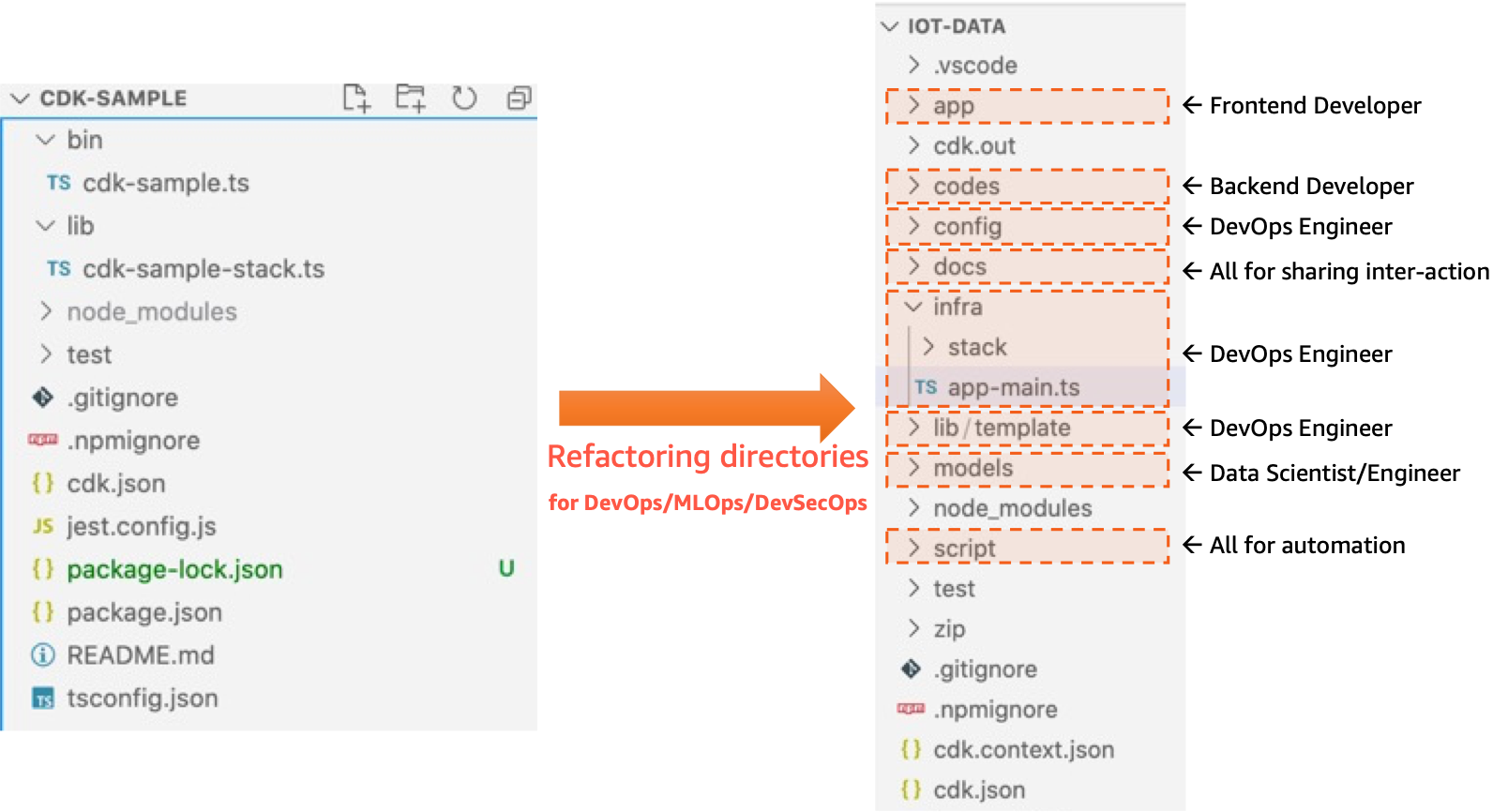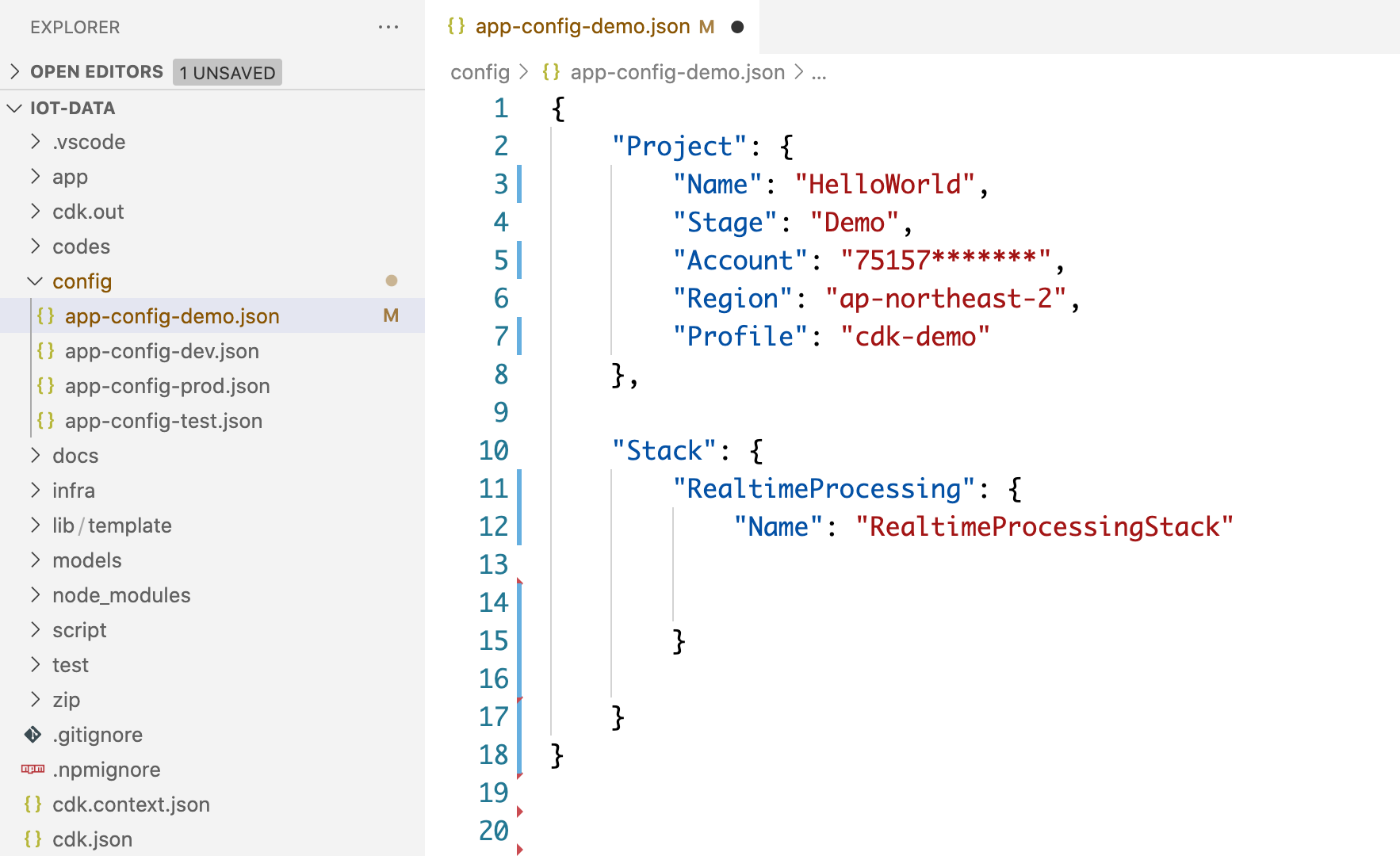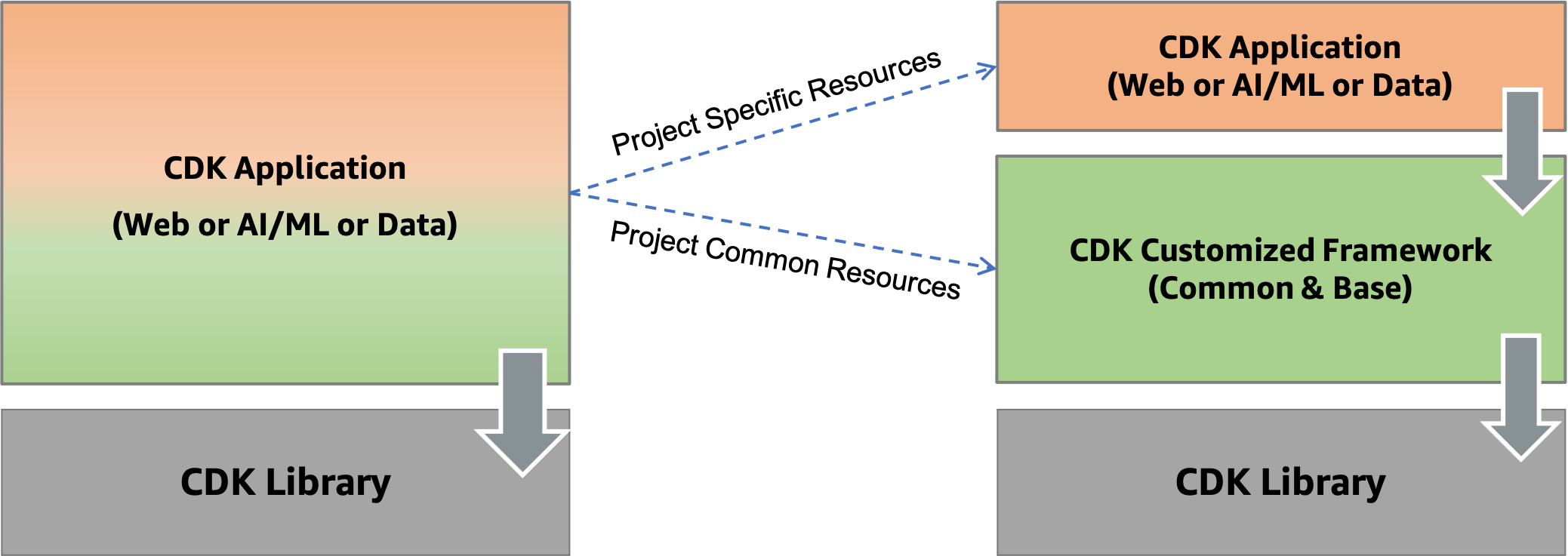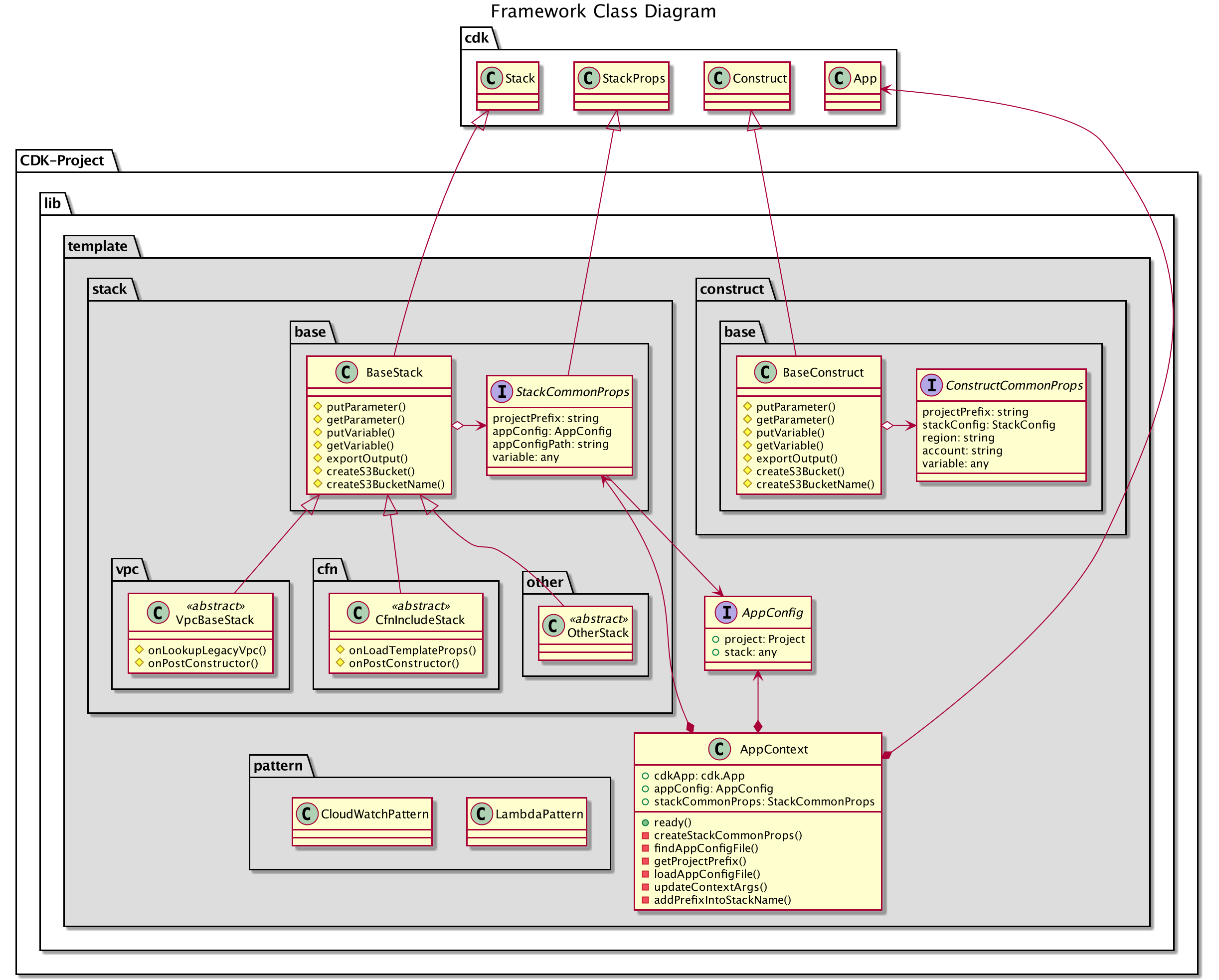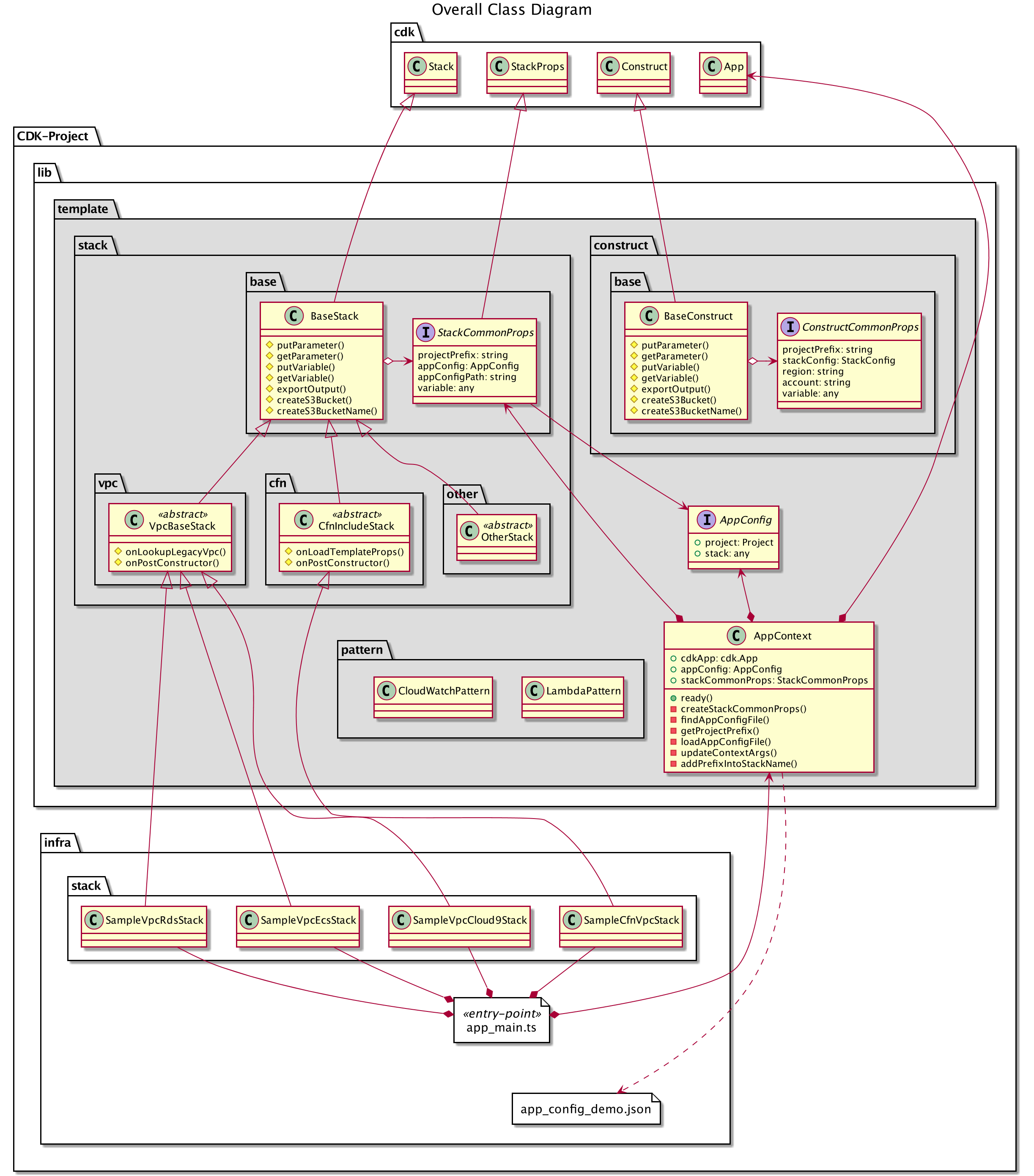This repository provides best practices and template framework for developing AWS Cloud Development Kit(CDK)-based applications effectively, quickly and collaboratively. In detail, practical approaches such as how to deploy to multi-environment, how to organize directories and how to manage dependencies between stacks will be introduced, and template codes are provided to support them. Gradually, these template codes will be further expanded to support various DevOps scenario.
-
3-a. DevOps Collaboration: How to organize directory for collaboration
3-b. Multi-Target Deployment: How to separate configuration from codes
3-c. Stack Independence: How to manage dependency between stacks
AWS Cloud Development Kit(CDK) is an open source software development framework to define your cloud application resources using familiar programming languages. After coding using CDK Construct and Stack, if you run it through CDK CLI, it is finally compiled and deployed through AWS CloudFormation.
AWS CDK supports TypeScript, JavaScript, Python, Java, C#/.Net, and (in developer preview) Go. The template codes of this repository are implemented in TypeScript, because it clearly defines restrictions on types. Restrictions on types provide automated/powerful guide within IDE.
Because AWS CDK is provided in a language that supports OOP(Object-Oriented Programming), it is possible to configure and deploy cloud resources in the most abstract and modern way. This repository provides a template framework by maximizing these characteristics.
npm installinstall dependencies only for Typescriptcdk listlist up all stackscdk deploydeploy this stack to your default or specific AWS account/regioncdk diffcompare deployed stack with current statecdk synthemits the synthesized CloudFormation templatecdk destroydestroy this stack to your default or specific AWS account/region
cdk.json in the root directory describes a entry-point file, in this repository we use infra/app-main.ts as the entry-point.
- CDK Intro: https://docs.aws.amazon.com/cdk/latest/guide/home.html
- CDK Getting Started: https://docs.aws.amazon.com/cdk/latest/guide/hello_world.html
- API Reference: https://docs.aws.amazon.com/cdk/api/latest/docs/aws-construct-library.html
- CDK Workshop: https://cdkworkshop.com/
- CDK Examples: https://github.com/aws-samples/aws-cdk-examples
First of all, AWS Account and IAM User is required. IAM user's credential keys also are requried.
To execute this template codes, the following modules must be installed.
- AWS CLI: aws --version
- Node.js: node --version
- AWS CDK: cdk --version
- jq: jq --version
Please refer to the kind guide in CDK Workshop.
Configure your AWS credential keys using AWS CLI.
aws configure --profile [your-profile]
AWS Access Key ID [None]: xxxxxx
AWS Secret Access Key [None]:yyyyyyyyyyyyyyyyyyyyyyyyyyyyyy
Default region name [None]: us-east-2
Default output format [None]: jsonIf you don't konw your account number, execute the following command:
aws sts get-caller-identity --profile [optional: your-profile]
...
...
{
"UserId": ".............",
"Account": "75157*******",
"Arn": "arn:aws:iam::75157*******:user/[your IAM User ID]"
}Several principles were selected to improve DevOps efficiency through AWS CDK. Conversely, if you are considering using AWS CDK as an IaC template for a one-time deployment, there is no need to apply these principles.
- Purpose: As an IaC tool for DevOps, it is very important to organize the directory of the project so that you can collaborate by role.
- Approach: I recommend having a separate directory for each role within a project so that each member interacts within a fence. The following figure shows the directory structure intuitively.
Although it is not an mandatory guide, it is necessary to configure this way so that development without boundaries between each other is possible. In particular, as the development paradigm shifts to serverless, the boundary between infrastructure(infra, config, lib) and business codes(app, codes, models) is disappearing.
- Purpose: Code and configuration should be separated so that they can be freely deployed to various AWS account/region without modifying the code.
- Approach: Prepare a json file for each distribution in
configdirectory in order to isolate the configuration from the code as much as possible. The following figure shows the configuration files inconfigdirectory.
Because we need to ensure that a single source code is maintained, all configurations are managed in config/app-config-[your-suffix].json. And several files are made according to the environment you want to deploy to, and you have to choose one of them when deploying.
Each config/app-config-[your-suffix].json file consists of two main parts in json format.
{
"Project": {
},
"Stack": {
}
}Project part describes project name and stage, and where to deploy.
The project name and stage are combined to create a unique project prefix, which is used as a prefix of all stacks.
Specifying AWS account number and region name in CDK source code causes us to modify the code per release. As a result, such information must be managed outside of the source code.
The final project part consists of:
{
"Project": {
"Name": "HelloWorld", <----- Essential: your project name, all stacks wil be prefixed with [Project.Name+Project.Stage]
"Stage": "Demo", <----- Essential: your project stage, all stacks wil be prefixed with [Project.Name+Project.Stage]
"Account": "75157*******", <----- Essential: update according to your AWS Account
"Region": "us-east-2", <----- Essential: update according to your target resion
"Profile": "cdk-demo" <----- Essential: AWS Profile, keep empty string if no profile configured
},
"Stack": {
}
}The above 5 items are mandatory, and if there is no profile name, you can leave it empty string.
In this example configuration, all stack names start with HelloWorldDemo. By setting this prefix, it is possible to deploy multiple stages to the same AWS account/region.
Usually a CDK project is implemented in several stacks, which have some degree of dependency on each other. Stack part describes detailed configuration of each stack. There is no need to define a standardized format because each stack requires different resource configurations, but the Name item must be declared because it is common.
A sample stack configuration consists of:
{
"Project": {
},
"Stack": {
"RealtimeProcessing": {
"Name": "DataProcessingStack",
"BucektName": "my-data",
"LambdaName": "my-function1",
"LambdaMemory": 256,
"LambdaPath": "codes/lambda/function-a/src",
}
"BatchJob": {
"Name": "BatchJobStack",
"VpcId": "vpc-yyyyyyyy",
"ECSClusterName": "main-cluster",
"ECSServiceName": "main-service",
}
}
}Set the path of this json configuration file through an environment variable. The key name of environment variable is APP_CONFIG, which can be modified in infra/app-main.ts file.
export APP_CONFIG=config/app-config-demo.jsonOr you can select this configuration file in command line like this:
cdk deploy *DataProcessingStack --context APP_CONFIG=config/app-config-demo.jsonThrough this external configuration injection, multiple deployments(multiple account, multiple region, multiple stage) are possible without code modification.
- Purpose: It should be possible to independently deploy each stack by removing the strong coupling between each stack.
- Approach: If
Outputof CloudFormation is directly referenced between stacks, a strong dependency occurs and deployment becomes difficult when there are many stacks. To solve this problem, I recommend placing a key-value registry between them and referencing each other. Of course, this method does not change that the deployment order of each stack must be respected, but once stored in the parameter store, independent deployment is possible afterwards. Luckily, AWS provides Parameter Store in System Manager, which is the best solution for this.
For frequently used parameter store access, we provide methods to help with this in our base class.
For parameter provider: putParameter()
import * as base from '../../../lib/template/stack/base/base-stack';
import { AppContext } from '../../../lib/template/app-context';
export class DataStoreStack extends base.BaseStack {
constructor(appContext: AppContext, stackConfig: any) {
super(appContext, stackConfig);
const ddbTable = this.createDdbTable();
this.putParameter('TableName', ddbTable.tableName)
}
...
}For parameter user: getParameter()
import * as base from '../../../lib/template/stack/base/base-stack';
import { AppContext } from '../../../lib/template/app-context';
export class DataProcessStack extends base.BaseStack {
constructor(appContext: AppContext, stackConfig: any) {
super(appContext, stackConfig);
const tableName = this.getParameter('TableName')
}
}- Purpose: Frequently reused workloads should be abstracted and easily reused without duplication of code.
- Approach: Frequently used patterns and resources are provided using OOP's template method pattern. That is, frequently used things will be provided through the parent class, and the child class will inherit and reuse it. This is an essential approach used in the process of creating a framework.
As shown in the figure above, we can now use the framework to focus on more core business logic and reliably speed up development.
The stack and construct corresponding to the parent class are planned to be gradually expanded based on the workload or pattern that is essential. All contributors are welcome on this, so please contact me.
This section explains how to use each base class with example code. First of all, please refer to the following overall class diagram. It is implemented with 4 stacks for a typical backend service.
This stack inherits from the parent stack(CfnIncludeStack). Write the information about CloudFormation template in the config, and pass this information to the onLoadTemplateProps function. The final loaded result is passed through onPostConstructor function.
- Stack Configuration
{
"Project": {
...
},
"Stack": {
"SampleCfnVpc": {
"Name": "SampleCfnVpcStack",
"TemplatePath": "infra/stack/template/sample-cfn-vpc.yaml",
"Parameters": [
{
"Key": "VpcName",
"Value": "HelloWorldDemo-Vpc"
}
]
},
"SampleVpcRds": {
...
},
"SampleVpcEcs": {
...
}
}
}- Stack Implementation
import * as ec2 from '@aws-cdk/aws-ec2';
import * as cfn_inc from '@aws-cdk/cloudformation-include';
import * as base from '../../lib/template/stack/cfn/cfn-include-stack';
import { AppContext } from '../../lib/template/app-context';
import { Override } from '../../lib/template/stack/base/base-stack';
export class SampleCfnVpcStack extends base.CfnIncludeStack {
constructor(appContext: AppContext, stackConfig: any) {
super(appContext, stackConfig);
}
@Override
onLoadTemplateProps(): base.CfnTemplateProps | undefined {
return {
templatePath: this.stackConfig.TemplatePath,
parameters: this.stackConfig.Parameters
};
}
@Override
onPostConstructor(cfnTemplate?: cfn_inc.CfnInclude) {
const cfnVpc = cfnTemplate?.getResource('VPC') as ec2.CfnVPC;
this.putVariable('VpcName', this.stackConfig.Parameters[0]['Value']);
}
}Saves VpcName in a local variable. this VPC parameter is utilized in SampleVpcRdsStack, SampleVpcEcsStack to load VPC.
This stack inherits from the parent stack(VpcBaseStack). Write the information about RDS Database in the config, and pass this information to the onLookupLegacyVpc function. The final loaded result is passed through onPostConstructor function.
- Stack Configuration
{
"Project": {
...
},
"Stack": {
"SampleCfnVpc": {
...
},
"SampleVpcRds": {
"Name": "SampleVpcRdsStack",
"ClusterIdentifier": "SampeDatabase",
"DatabaseName": "helloworld"
},
"SampleVpcEcs": {
...
},
}
}- Stack Implementation
import * as cdk from '@aws-cdk/core';
import * as ec2 from '@aws-cdk/aws-ec2';
import * as rds from '@aws-cdk/aws-rds';
import * as base from '../../lib/template/stack/vpc/vpc-base-stack';
import { AppContext } from '../../lib/template/app-context';
import { Override } from '../../lib/template/stack/base/base-stack';
export class SampleVpcRdsStack extends base.VpcBaseStack {
constructor(appContext: AppContext, stackConfig: any) {
super(appContext, stackConfig);
}
@Override
onLookupLegacyVpc(): base.VpcLegacyLookupProps | undefined {
return {
vpcNameLegacy: this.getVariable('VpcName')
};
}
@Override
onPostConstructor(baseVpc?: ec2.IVpc) {
const cluster = new rds.ServerlessCluster(this, 'serverless-rds', {
vpc: baseVpc!,
clusterIdentifier: `${this.projectPrefix}-${this.stackConfig.ClusterIdentifier}`,
defaultDatabaseName: this.stackConfig.DatabaseName,
engine: rds.DatabaseClusterEngine.AURORA_MYSQL,
scaling: {
autoPause: cdk.Duration.minutes(10),
minCapacity: rds.AuroraCapacityUnit.ACU_8,
maxCapacity: rds.AuroraCapacityUnit.ACU_32,
},
removalPolicy: cdk.RemovalPolicy.RETAIN,
});
this.putParameter('DatabaseHostName', cluster.clusterEndpoint.hostname);
this.putParameter('DatabaseAddress', cluster.clusterEndpoint.socketAddress);
this.putParameter('DatabaseName', this.stackConfig.DatabaseName);
this.putParameter('DatabaseSecreteArn', cluster.secret?.secretArn!);
this.putParameter('DatabaseSecurityGroup', cluster.connections.securityGroups[0].securityGroupId);
}
}Import VpcName through getVariable function. This technique avoids hard-coding, helping flexible deployments. And database parameters are saved through putParateter method.
This stack inherits from the parent stack(VpcBaseStack). Write the information about ECS Cluster in the config, and pass this information to the onLookupLegacyVpc function. The final loaded result is passed through onPostConstructor function.
- Stack Configuration
{
"Project": {
...
},
"Stack": {
"SampleCfnVpc": {
...
},
"SampleVpcRds": {
...
},
"SampleVpcEcs": {
"Name": "SampleVpcEcsStack",
"ClusterName": "SampleCluster",
"FilePath": "codes/sample-backend-fastapi",
"Memory": 1024,
"Cpu": 512,
"DesiredCount": 1
},
}
}- Stack Implementation
import * as ec2 from '@aws-cdk/aws-ec2';
import * as ecs from '@aws-cdk/aws-ecs';
import * as sm from '@aws-cdk/aws-secretsmanager';
import * as ecsPatterns from '@aws-cdk/aws-ecs-patterns';
import * as base from '../../lib/template/stack/vpc/vpc-base-stack';
import { AppContext } from '../../lib/template/app-context';
import { Override } from '../../lib/template/stack/base/base-stack';
export class SampleVpcEcsStack extends base.VpcBaseStack {
constructor(appContext: AppContext, stackConfig: any) {
super(appContext, stackConfig);
}
@Override
onLookupLegacyVpc(): base.VpcLegacyLookupProps | undefined {
return {
vpcNameLegacy: this.getVariable('VpcName')
};
}
@Override
onPostConstructor(baseVpc?: ec2.IVpc) {
const databaseHostName = this.getParameter('DatabaseHostName');
const databaseName = this.getParameter('DatabaseName');
const databaseSecreteArn = this.getParameter('DatabaseSecreteArn');
const databaseSecrete = sm.Secret.fromSecretCompleteArn(this, 'secrete', databaseSecreteArn);
const taskDef = new ecs.FargateTaskDefinition(this, 'TaskDef');
taskDef.addContainer('DefaultContainer', {
image: ecs.ContainerImage.fromAsset(this.stackConfig.FilePath),
logging: new ecs.AwsLogDriver({
streamPrefix: `${this.projectPrefix}-backend-fastapi`
}),
environment: {
HOST_NAME: databaseHostName,
DATABASE_NAME: databaseName,
SECRETE_ARN: databaseSecreteArn,
},
portMappings: [{
containerPort: 80,
protocol: ecs.Protocol.TCP
}]
});
databaseSecrete.grantRead(taskDef.taskRole);
const albEcsService = new ecsPatterns.ApplicationLoadBalancedFargateService(this, 'Service', {
cluster: new ecs.Cluster(this, 'cluster', {
vpc: baseVpc,
clusterName: `${this.projectPrefix}-${this.stackConfig.ClusterName}`
}),
memoryLimitMiB: this.stackConfig.Memory,
cpu: this.stackConfig.Cpu,
taskDefinition: taskDef,
publicLoadBalancer: false,
desiredCount: parseInt(this.stackConfig.DesiredCount)
});
const databaseSecurityGroup = ec2.SecurityGroup.fromSecurityGroupId(this, 'DatabaseSecurityGroup', this.getParameter('DatabaseSecurityGroup'));
databaseSecurityGroup.addIngressRule(albEcsService.service.connections.securityGroups[0], ec2.Port.tcp(3306), 'from backend sg');
}
}Database information is passed to ECS through environment variables.
Execute the following command:
sh scripts/setup_initial.sh config/app-config-demo.jsonFor more details, open scripts/setup_initial.sh file.
Caution: This solution contains not-free tier AWS services. So be careful about the possible costs.
Since each stack refers to each other through Parameter Store, it must be deployed sequentially during the only first deployment. After that, independent deployment is possible.
You can deploy the entire stacks by running:
sh scripts/deploy_stacks.sh config/app-config-demo.jsonYou can find the deployment results in AWS CloudFormation.
Execute the following command, which will destroy all resources except RDS Database. So destroy these resources in AWS web console manually(Go RDS -> Select RDS Name -> Modify -> disable deletion protection -> Select again -> Delete).
sh ./script/destroy_stacks.sh config/app-config-demo.json- Amazon Sagemaker Model Serving Using AWS CDK
- AWS ECS DevOps UsingAWS CDK
- AWS Serverless Using AWS CDK
- AWS IoT Greengrass Ver2 using AWS CDK
- Amazon SageMaker Built-in Algorithm MLOps Pipeline using AWS CDK
See CONTRIBUTING for more information.
This library is licensed under the MIT-0 License. See the LICENSE file.

